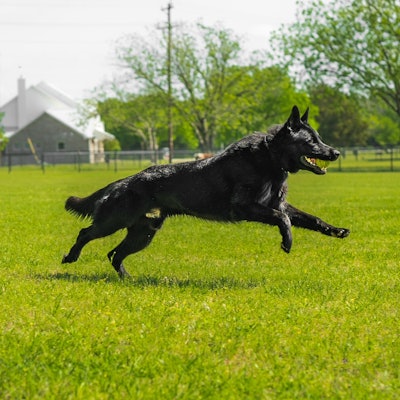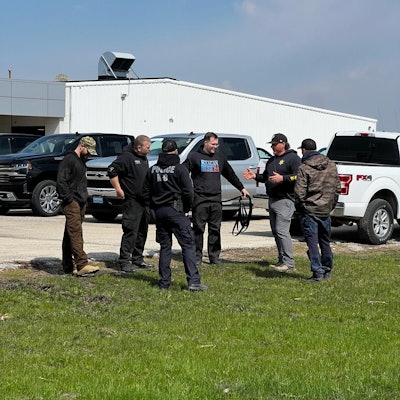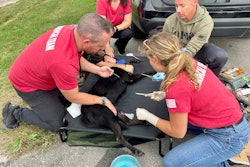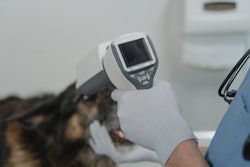 It's crucial to get a clear picture of the police dog's capabilities and compare them to a baseline test that filters out the good ones from the bad ones.IMAGE: Scott’s Police K9 LLC
It's crucial to get a clear picture of the police dog's capabilities and compare them to a baseline test that filters out the good ones from the bad ones.IMAGE: Scott’s Police K9 LLC
Choosing the right police dog is crucial to a K9 program’s success. It is as important as picking the right handler and setting good policy. Not every dog is suitable for police work, says Matt Grienlief, who has dedicated himself to training and selecting police dogs for two decades.
In 2019, this seasoned law enforcement veteran took his experience as a K9 handler and trainer, and opened a kennel dedicated to selecting and training police dogs. Today, Cedar Creek Kennels LLC imports dogs from one to three years old and places them in police departments. Grienlief also offers specialized training to ensure teams perform at a high level and was selected by the State of Illinois to assess narcotics K9s in their certification tests.
U.S. Army Veteran Stephen Scott also stresses the importance of choosing the right dog for police service.
During his time in the service, Scott established connections with leading protection dog kennels in Europe. Later, Scott entered law enforcement and became the head trainer of his police department before opening Scott’s Police K9 LLC, an Argyle, Texas, kennel, known for producing top police dogs.
Grienlief and Scott recently shared their thoughts about how to pick a dog that will perform as intended.
“Selecting dogs to become police dogs is something that truly takes getting the complete picture of the dog,” Scott says. “Having a baseline test that weeds out the good from the bad is important. There are many tests that will help identify the best. But I also think that many times your gut and experience can tell you right away if a dog is good or not. When I see a young dog in an unfamiliar environment and see pictures he’s never seen and his tail is up and he’s eager to complete the task, that’s usually an indication that this dog will be exactly what I’m looking for.”
Take in the Dog’s Temperament
Topping these experts lists of things to look for is temperament. They say the right police dog is confident, social, and shows a willingness to handle stressful situations.
Grienlief explains a dog might have powerful drives to hunt and search, but if it isn’t environmentally sound, “you will not be searching for anything. I look for the dogs that don’t care where they are at, whether it’s a pile of rubble, steps, a platform or a tunnel.”
According to Scott, environmentally sound dogs are unafraid of slick floors, loud noises, stairs, or gunfire.
“You are looking for an all-around stable dog with an intense willingness to work in any environment; a dog that shows confidence in any situation,” he says. “The body posture of the dog will tell you what you need to know. Tail up, ears up, in an unfamiliar environment, is what we look for. That shows a confident dog.”
Scott holds the belief that some individuals think a police dog should exhibit characteristics resembling a "junkyard dog," such as a strong, intimidating bark and a menacing presence. “But that is a nervy, scared dog,” he says.
Both Scott and Grienlief assess environmental soundness with various tests. They expose K9 candidates to countless settings, including stairs, slippery floors, department stores, and crowded places to evaluate their skills.
“Some people have a pit filled with water bottles, soda cans and things like that, then throw a toy into it,” Grienlief says. “The dog has to retrieve the toy while they are unsure of their footing. This is a crucial test. Some dogs refuse to be in that position.”
Study the Dog’s Socialization
Though police dogs will be routinely exposed to people and need to be social, they cannot be too social, adds Grienlief. A labrador retriever that considers everyone their friend may not be the most suitable choice.
An ideal dog is sociable in crowded environments, and capable of performing necessary tasks.
“Sociability is huge,” says Scott. “The dog has to be social enough but also able to handle aggression. You can’t have a dog that is just out there to be social with every single person. It will never work.”
In a group of new people, some dogs get anxious and look for a way to escape. The ideal dog is one that stays calm and neutral in these situations, they add.
“I like a dog that doesn’t care if there are five or 100 people there,” Scott says. “Socializing isn’t wanting to go up and greet those people. A well-socialized dog doesn’t care that people are there and is not distracted by them. They are not trying to engage them. They are also not aggressive toward them.”
Socializing dogs when they are young is key, Grienlief adds, noting some people consider socializing as taking K9s to the dog park and letting them run around.
“That’s not socializing,” he says. “Socializing is taking them in as many environments as you can. Walk them on the street. Take them into business or a school. Expose them to as many environments as you can.”
He adds to watch how the dog behaves in these environments.
“I test dogs by taking them to my training building. I can tell right away how they are going to be. Is their tail up or tucked between their legs? Are they hunched down or standing tall?” he asks. “If they can walk into a room, they’ve never been in before, with people they’ve never seen before, and are comfortable in that environment, they are confident dogs.”
Pick Up On Their Prey, Fight and Hunt Drive
“Dogs must have excellent fight drive and over the top prey and hunt drive,” says Scott. “A dog without enough prey or hunt drive, defense or fight drive, will fail. We like a dog that will retrieve anything.”
Grienlief sees how determined a dog is by hiding a toy and getting the dog to look for it. He wants the dog to work to find the toy.
“I like it when dogs cannot find the toy right away. I want to see if that dog’s hunt becomes more intense,” he says.
In other words, does the dog continue to work if he doesn’t find the toy in the first 5 seconds, 10 seconds, 30 seconds or a minute? “If I throw a toy into a grassy area and the dog doesn’t find it in five minutes, I’m 100% OK with that if he continues to hunt and his intensity increases. That is one thing I look for, especially with detection dogs,” he says.
Scott agrees, saying you want a dog that can go through anything to fetch a ball. “That dog will be a police dog that will search five cars or an entire house to find what he’s looking for,” he says.
A good police dog also needs a strong fight drive because police dogs will encounter punches, yelling, and must understand the conflict, according to Scott.
“People are going to lash out and you need a dog that’s going to stand there cool and collected and not bite them, unless they are commanded to bite,” he says.
Bite suits and sleeves are an excellent test of a dog’s fight drive. “You want a dog that pushes into the grip and wants more of the suit in his mouth,” Scott says. “Not a dog that bites frontal and turns his head, showing he’s uncomfortable on the bite. That may be a sign of weak nerves.”
He explains a dog is barely hanging on with a frontal bite. “They are afraid the person will hurt them,” he says. “A dog pushing into the grip is confident. That’s what I’m looking for. I want a dog that’s going to completely own the guy.”
According to Grienlief, a dog without confidence won't stand up to a violent felon. “They must show willingness to engage and show confidence when a threat is presented,” he says.
Get Physical
 Once a dog is selected, the handler and dog must complete weeks of additional training before they can officially begin working together.IMAGE: Cedar Creek Kennels LLC
Once a dog is selected, the handler and dog must complete weeks of additional training before they can officially begin working together.IMAGE: Cedar Creek Kennels LLC
“Proper genetics and a conscientious upbringing play an integral part in developing the proper traits for police service dog,” writes R.S Eden in the “K9 Supervisors Manual.” “A good selection testing process will eliminate dogs that exhibit signs of weak genetics and improper training.”
Most police dogs are imported from the Netherlands when they are one to three years of age. By that point, it should be easy to spot genetic issues. However, it’s also important to X-ray hips, elbows, spine and teeth to make sure nothing gets missed, according to Scott.
Both Scott and Grienlief import dogs that are 18 months to two years old from the Netherlands and prefer dogs with a foundation of KNPV, the Royal Dutch Police Certification. “I’ve found their initial training mirrors what we do in the states as far a police dog,” Scott says.
Though the dogs have some level of training, they will need more once they arrive to ready them for police work. Once departments select a dog, Grienlief explains the handler and dog work together in a 10-week training class at his kennel.
“This is a crucial time for us,” he says. “If we see something where the handler is not comfortable with the dog or the dog is too much for the handler, we’re going to make a swap because they will not be a productive team.”
There’s also specific training that dogs must go through depending on their discipline. One dog might train in tracking, another in searching, narcotics or explosives, and patrol.
“The dogs have already had basic obedience and we are tweaking from there,” Scott concludes.


















